A Creative Guide to Make Words Rhyme
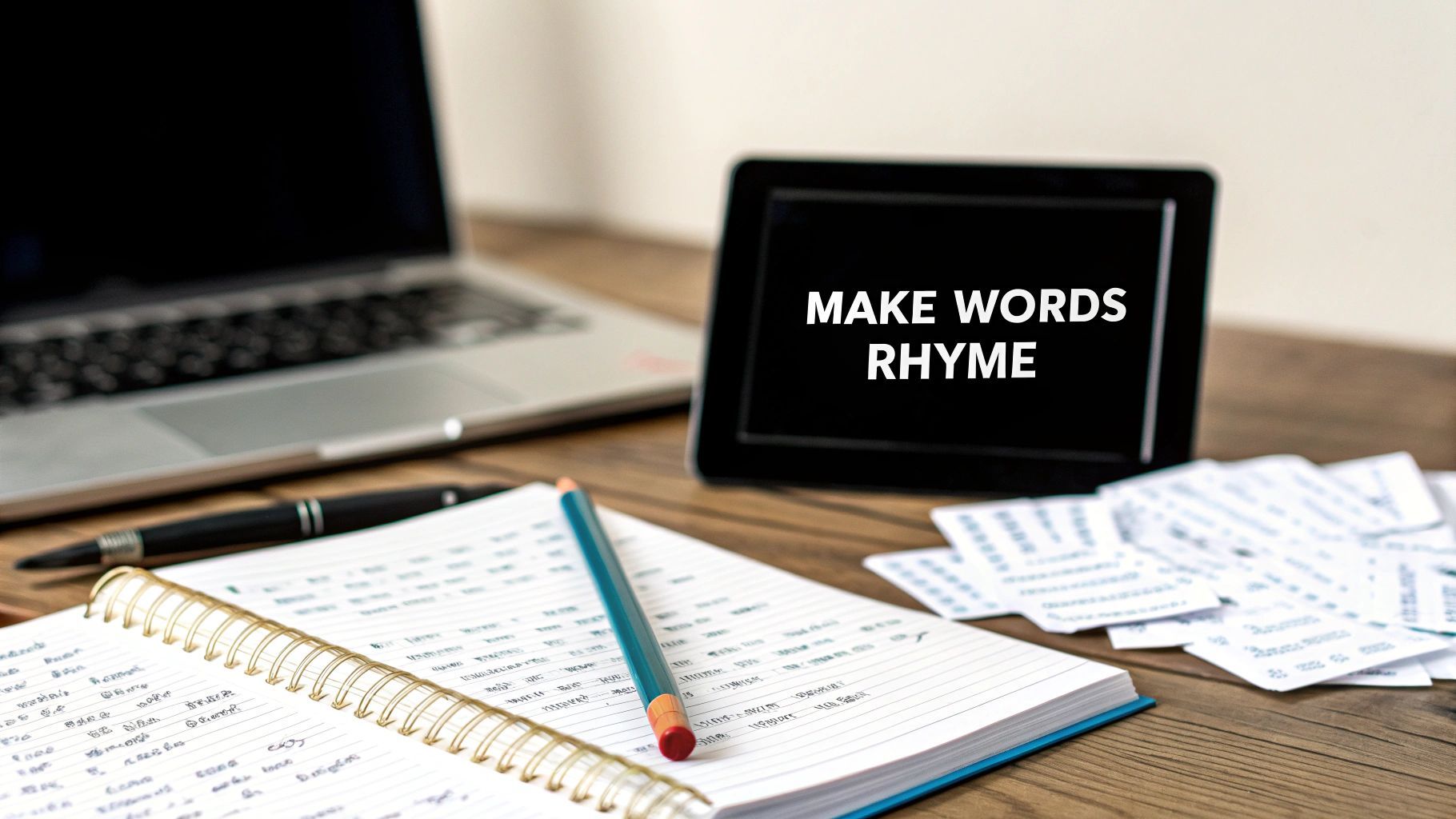


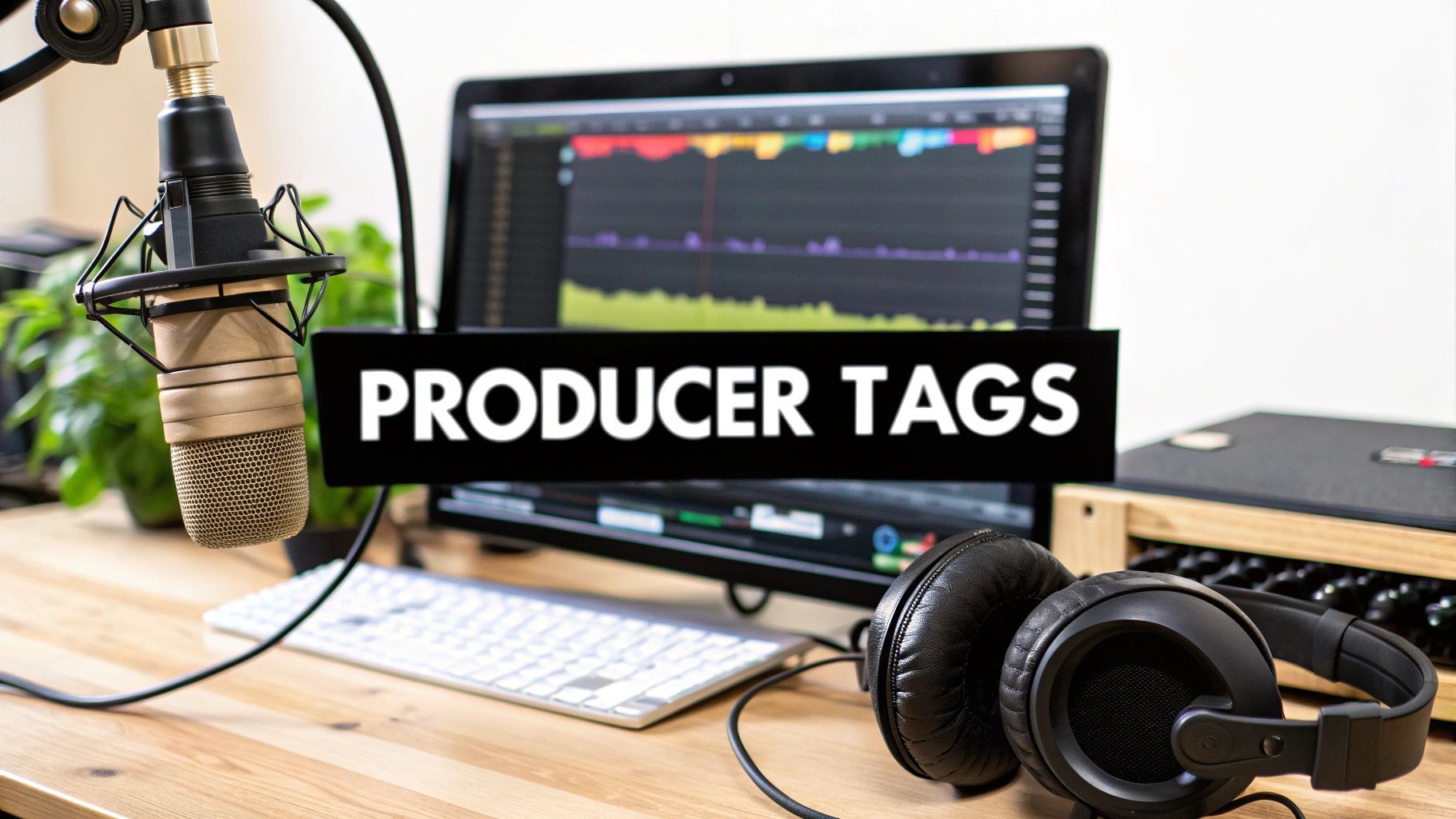
Discover how to make producer tags that define your sound. This guide covers scripting, AI voice generation, recording, and adding effects for a unique tag.
So, you've decided to create a producer tag. It's a simple idea: you script a short phrase, record it, and then sprinkle on some audio magic like EQ and reverb. But what you're really doing is creating your own sonic calling card—a signature that protects your beats and makes them unforgettable.
Before we get into the nuts and bolts of making your tag, let's talk about why it's such a game-changer. A producer tag is your sonic business card. It's that short, unforgettable audio clip that screams, "I made this beat!"
Think about it. When you hear Metro Boomin's iconic whisper or DJ Khaled's triumphant "Another one!", you know exactly who's behind the track. It's way more than a simple credit; it's a powerful branding weapon in a music scene that's packed with talent.
Your tag is the first real step toward building an identity that people remember. When an artist or a fan hears it, they instantly connect that sound with you. That's how you build a reputation and get people excited for your next drop, turning casual listeners into loyal fans.
A killer tag does more than just say your name. It's your first line of defense against beat theft, making sure you get credit no matter where your music ends up. In a world of viral TikTok sounds and never-ending Spotify playlists, that tag is your stamp of ownership. It turns your beat from just another track into a branded piece of art.
Here’s what a great producer tag really does for you:
Instant Recognition: A consistent tag makes your sound pop, helping you cut through the clutter. Beat Protection: It’s basically a sonic watermark, telling would-be thieves to back off and ensuring your name stays on your work. A Professional Vibe: A polished, well-made tag signals that you're serious about your craft, earning you respect from artists and A&Rs. Marketing Gold: The catchiest tags become part of the culture, blowing up your visibility and making you a go-to producer for major placements.
Ultimately, producer tags are one of the most effective tools for brand recognition in music. If you want to go deeper on this, there are some proven strategies for building brand awareness that apply here, too.
A producer tag is your audio logo. It needs to be as unique and memorable as your sound itself. Don't just slap your name on a beat—create an experience that starts the second your tag plays.
Historically, tags weren't always so slick. They started as simple vocal shout-outs on mixtapes before evolving into the sophisticated audio marks we hear today. The rise of DAWs (Digital Audio Workstations) let producers bake their identity right into their tracks, and things have never been the same.
This evolution is a huge deal in a global electronic music market now valued at over $12.9 billion. In fact, some studies show tracks with distinctive tags can get a 15-20% higher recognition rate on streaming platforms. It’s a clear sign of just how much intellectual property and brand identity matter in today's music business.
When you get right down to it, your tag is your legacy, embedded in every single track you create.
So, how do you actually get one? There are a few different paths you can take, each with its own vibe. Here's a quick look at the three main ways to get your tag made, so you can figure out what works best for you.
| Method | Best For | Pros | Cons |
|---|---|---|---|
| DIY (Do-It-Yourself) | Producers who want total creative control and have some recording gear. | Complete control over the sound, no cost, highly personal. | Requires decent mic/setup, vocal performance skills, and mixing knowledge. |
| Hiring a Voice Actor | Producers looking for a specific professional voice or a unique character. | Professional quality, wide range of voices, saves you time. | Can be expensive, may require revisions, less personal touch. |
| Using AI Voice Generators | Producers who need something fast, affordable, and easily customizable. | Extremely fast, budget-friendly, endless options and easy edits. | Can sometimes sound less natural, potential for less uniqueness if overused. |
Choosing the right method really comes down to your budget, your skills, and the kind of vibe you're going for. Whether you decide to record it yourself, hire a pro, or use an AI tool, the most important thing is that the final product sounds like you.
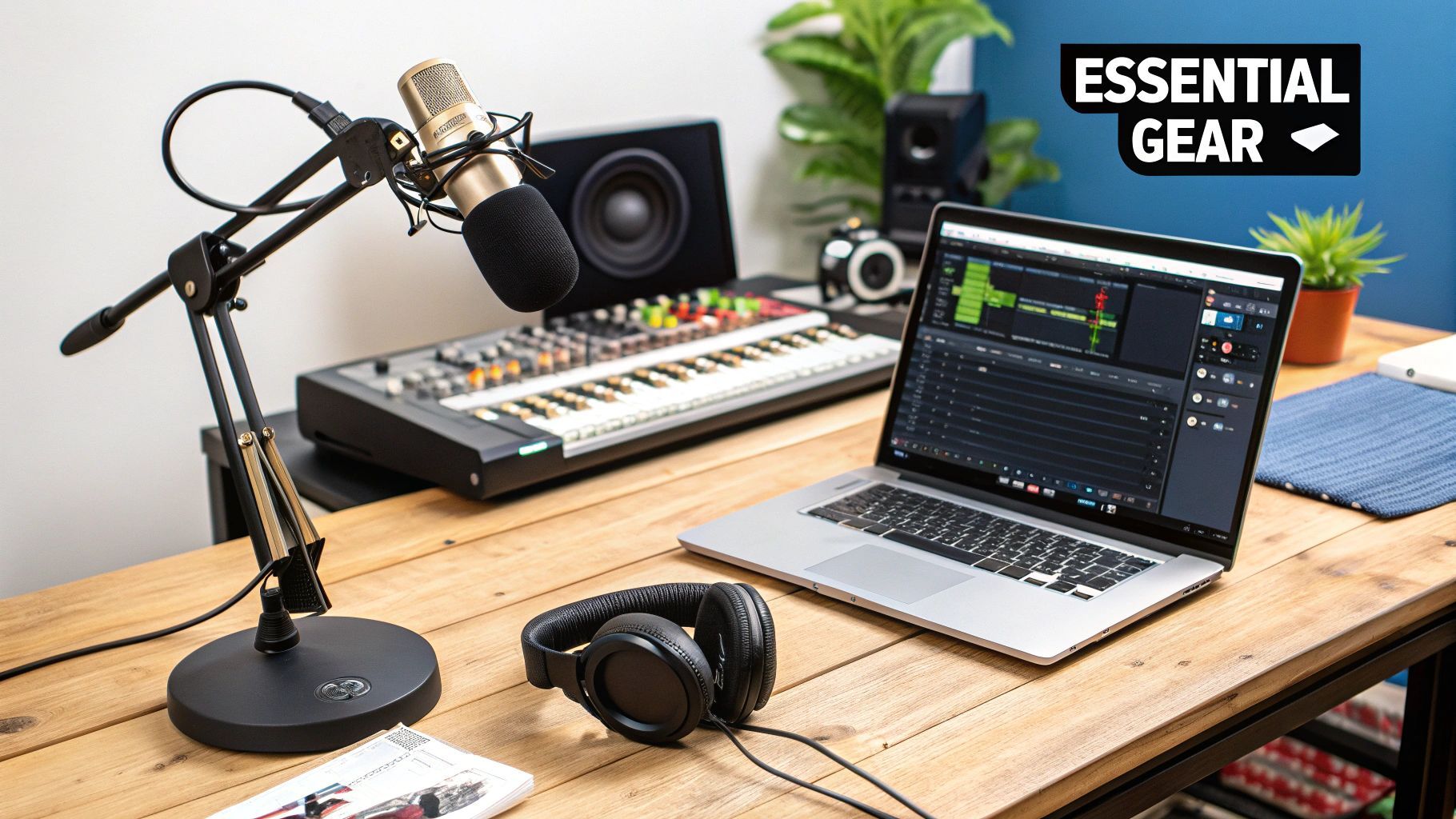
Let's be real: your tag's script is its soul. A boring script leads to a forgettable tag, and that's the last thing you want. This is your chance to move beyond the generic "Your Name on the beat!" and cook up a phrase that actually lives rent-free in a listener's head.
A truly great tag is like a micro-story. It needs to be short, punchy, and instantly recognizable. Just think about Tay Keith’s legendary "Tay Keith, f— these n—s up!"—it’s aggressive, unforgettable, and sets the tone perfectly for his hard-hitting beats. Or consider Murda Beatz’s simple but menacing laugh. Both tell you everything you need to know before the 808s even drop.
The main goal here is to land on a phrase that feels authentic to you. Don't try to force some catchphrase that clashes with your personality or the music you make.
First, think about your brand. What’s the core feeling of your music? Is it dark and gritty? Playful and energetic? Maybe it’s smooth and soulful. Whatever it is, your tag should be a perfect reflection of that vibe.
Grab a notebook (or your phone) and just start brain-dumping. Jot down any words, phrases, or weird ideas that pop into your head. Don't censor yourself—the good stuff often comes from the weird stuff.
Here are a few angles to get you started:
Your Alias: Just say your producer name. Seriously. Play with different tones, rhythms, and deliveries. Sometimes the simplest option hits the hardest if the performance is unique. A Personal Catchphrase: Is there something you always say in the studio? An inside joke or some slang that’s specific to you and your crew? A Clever Question: A tag like Pierre Bourne's "Yo Pierre, you wanna come out here?" creates a tiny bit of a story and makes people lean in, curious. An Abstract Sound: Who says you need words? A signature sound effect, a cool laugh, or a weirdly chopped vocal sample can be just as powerful, if not more so.
The most iconic tags are rarely the first idea. They come from messing around with different phrases, tones, and deliveries until something just clicks. Your tag should feel less like a stuffy announcement and more like the kick-off to the main event.
Once you’ve got a list of contenders, start saying them out loud. How do they feel rolling off the tongue? A phrase that looks brilliant on paper can sound totally awkward when spoken.
Record a few of your favorites on your phone and listen back with fresh ears. Better yet, play them for a trusted friend and get their honest gut reaction. Which one gets stuck in their head? This little testing phase is what separates a decent tag from a legendary one.
This whole creative process isn't that different from when you generate music with AI; you’re essentially testing different prompts and styles to find that perfect result. The principle is the same here: keep tweaking and iterating until it feels right. Your script is the foundation, so make sure it's rock-solid before you even think about stepping up to the mic.
Alright, you've got your script. Now for the fun part: bringing it to life. When it comes to capturing that perfect voice, you're basically at a crossroads. You can go the traditional route and record it yourself (the DIY method), or you can jump into the future with AI tools. Both paths lead to a killer tag, but the journey is completely different.
Going DIY gives you the ultimate creative control. And no, you don't need to book time at Abbey Road. Your smartphone can actually do a decent job if you're clever about your setup. The secret is finding a quiet space. Think of your closet full of clothes—it's a natural sound-dampener. Or, build a little pillow fort around your microphone. The goal is to kill any echo or background noise.
If you're voicing it yourself, play around. Try different deliveries—a whisper, a shout, something more laid-back. If you've roped a friend into helping, give them solid direction. Instead of saying "do it again," try something like, "More energy this time, like you just won the lottery!" You're hunting for a raw take that's clean but packed with personality.
What if you could skip the mic setup entirely? Welcome to the world of AI. The recent explosion in AI music production has been a total game-changer for creating producer tags. Instead of wrestling with a recording for hours, you can spit out dozens of pro-level options in a few minutes.
This isn't just about saving time; it's about unlocking creative doors you didn't even know were there. Curious about how your tag sounds with a deep male voice? A soft female whisper? A robotic tone? You can explore all of that without ever touching a microphone.
Take SendFame’s voice generator, for example. You just type in your tag, pick a voice that fits your vibe, and—boom—you have a high-quality audio file ready to go. You can even check out some of the top AI voice generators to see the incredible variety out there.
The real power of AI isn't just about speed. It’s the endless creative sandbox it gives you. It’s like having an entire cast of A-list voice actors on speed dial, 24/7, ready to try anything you can think of.
This image shows the core of the DIY process—a solid mic setup.
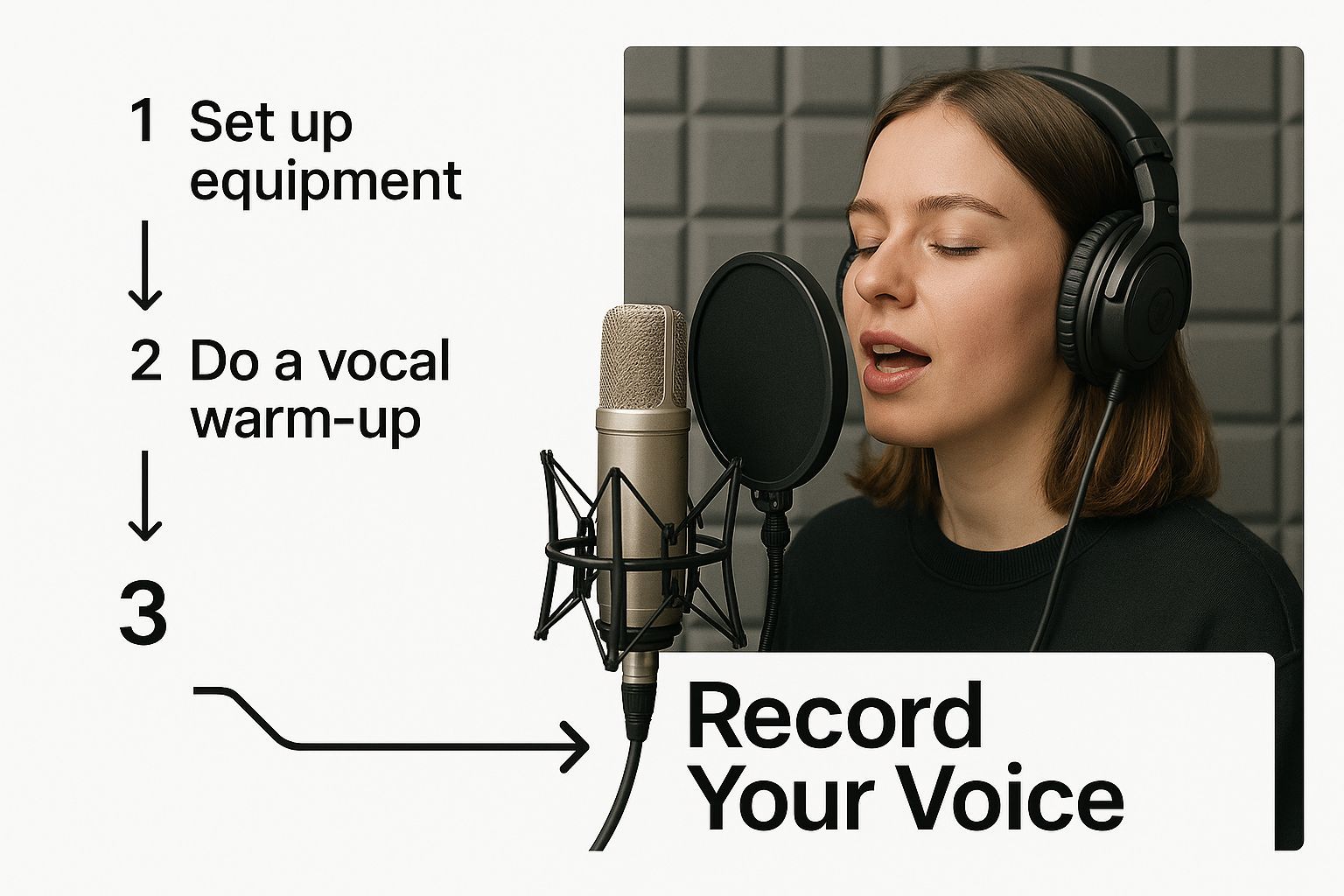
As you can see, a quality microphone and some basic acoustic treatment are non-negotiable if you want a clean DIY recording.
Honestly, there’s no wrong answer here. It all boils down to what you need.
Go DIY if... you're after a sound that is 100% uniquely you. If you love the craft of recording and want your tag to have that human touch, this is your lane. Use AI if... you need something that sounds professional, and you need it fast. It's also the perfect choice if you want to experiment with a ton of different styles without buying any gear.
Make no mistake, having a distinct audio brand is more important than ever. The market for digital tags is projected to explode, jumping from USD 12.8 billion in 2025 to nearly USD 23 billion by 2035. That's a massive signal that producers need a unique sonic signature to stand out and protect their beats.
Whether you're recording your own voice or diving into the incredible world of AI music production, the mission is the same: capture a voice that truly represents your brand.
https://www.youtube.com/embed/3oPPYtW9nkQ
Alright, so you've got your raw vocal take. That's a great start, but it's just the beginning. The real magic—the stuff that turns a simple recording into an iconic sonic brand—happens when you start slathering on the audio effects. This is where you mold that plain voice into something that punches through a mix and gets stuck in a listener's head for days.
Think of your raw audio like a block of marble. You’ve got the raw material, but now you need to chisel it into a masterpiece. A pro-level effects chain, which you can set up in any DAW like FL Studio or Ableton Live, is your set of chisels. Let's walk through building one that'll make your tag pop.
First things first: your effects chain should always begin with subtractive EQ. Before you even think about boosting frequencies to make your tag sound brighter or fatter, you have to clean up the mess. The goal here is to carve out any mud, rumble, or harshness that’s just going to get in the way of the beat.
Your main targets are the extreme ends of the frequency spectrum.
High-Pass Filter: Slap this on to cut out all the low-end junk below 80-100 Hz. This is where the kick and bass live, and your vocal tag has absolutely no business being down there. This one move works wonders for creating instant space in the mix. Low-Pass Filter: On the other end, gently roll off the super-high frequencies above 15-18 kHz. Most of what’s up there is just airy hiss and digital noise. Trimming it makes the vocal feel smoother and less brittle.
We’re not trying to drastically change the sound just yet. This is purely about creating a clean, focused vocal that’s ready for the real fun to begin.
Next up is the compressor. A compressor's job is simple: it evens out the volume, squashing the loud parts and lifting the quiet ones. For a producer tag, this is non-negotiable. It ensures every single syllable is audible and hits with impact.
You need your tag to sound confident, not like it's hiding behind the 808s. A great starting point is a 4:1 ratio with a fast attack and a medium release. This will grab the initial transient of each word and glue the whole phrase together, making it sound way more powerful and polished. The trick is to make it sound energetic, not squashed into a pancake.
Your effects chain tells a story. EQ cleans the slate, compression adds the punch, and creative effects paint the picture. Each plugin should have a specific purpose, working together to build your unique sonic identity.
With the boring-but-necessary stuff out of the way, it's time to get weird. This is where you inject your personality and cook up a sound that’s uniquely yours. The possibilities are literally endless, but here are a few classic and creative tricks to get you started.
Reverb and Delay: These are your tools for creating space. A short, tight reverb can make the tag feel like it’s right there in the room with the instruments. On the other hand, a long, sweeping delay can create an epic, trailing-off vibe. Try syncing a simple quarter-note delay to your track’s tempo for that classic rhythmic echo. The "Telephone EQ" Trick: This is a legendary move. Use an EQ to make some drastic cuts—chop everything below 300 Hz and everything above 3 kHz. What's left is that crunchy, lo-fi, walkie-talkie sound that slices through any mix like a hot knife. Creative Modulation: Don't be shy about experimenting with the wilder stuff. A slow-moving flanger or phaser can add a swirling, psychedelic texture that’s impossible to ignore. A subtle pitch shifter can give the voice an eerie, otherworldly, or even robotic quality.
Honestly, the best way to find your sound is to just mess around. Drag different effects onto the channel, twist the knobs like a mad scientist, and just listen. Your signature sound is in there somewhere, waiting for you to find it.
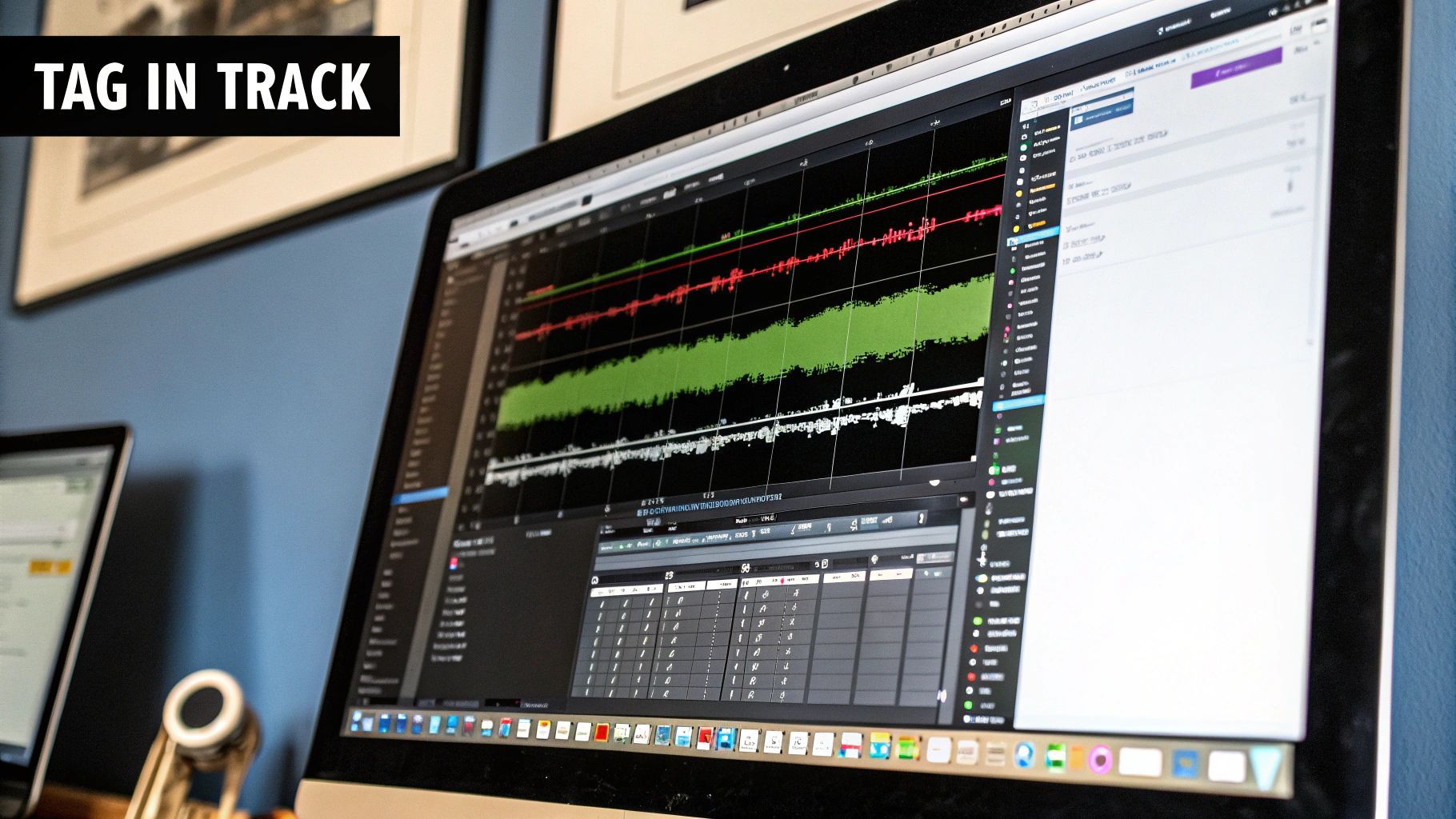
Alright, so you've scripted, recorded, and mixed a killer tag. Now for the million-dollar question: where the heck do you put it? Just dropping it randomly into a track is like throwing a masterpiece painting in a cluttered garage—its impact gets totally lost.
Effective placement is a genuine art form. It’s a strategic choice that can elevate a beat from pretty good to absolutely legendary. The placement sets the entire mood and acts as the first handshake with your listener, so you’ve got to make it count. The goal is to weave your tag into the track's DNA, not make it a clunky interruption that yanks people out of the vibe.
Figuring out where your tag lands is a huge decision. Different spots create completely different feelings, and the best producers have a sixth sense for matching the placement to the energy of the beat.
Here are the go-to strategies that always seem to work:
The Classic Intro: Sticking your tag right at the very beginning is the most popular move for a reason. It’s an immediate announcement, building hype and letting everyone know who’s behind the sound before the first 808 even hits. The Pre-Drop Punch: This is a serious power move. Dropping your tag just a moment before the main beat or chorus kicks in builds an insane amount of tension. It’s the sonic equivalent of a rollercoaster climbing to its peak right before the big drop. The Subtle Echo: Instead of a loud, in-your-face placement, you can chop your tag up and weave it into the background. Add some delay or drench it in reverb, and it becomes a recurring textural layer that reinforces your brand without screaming for attention.
Your tag placement should never feel like an afterthought. It should feel like the first instrument in the track, setting the stage for everything that follows. Treat it with the same creative respect as your melodies and drum patterns.
Your tag’s job doesn’t end when the song fades out. To build a truly powerful brand, you need to slap that signature sound on everything. This is how you transform it from a simple watermark into a marketing powerhouse that builds your legacy across every platform.
Think bigger than just your DAW. Your tag should be the sonic glue for your entire online presence. Use it as a recurring sound on your TikToks and Instagram Reels when you post beat-making videos or studio sessions. Our guide on how to make an AI music video can also spark some ideas for visually branding your content, with your tag as the audio signature.
In a world drowning in digital content, this consistency is everything. In booming markets like India, where YouTube’s user base ballooned to 450 million in 2024, a memorable tag is non-negotiable for cutting through the noise. Getting familiar with broader social media content creation tips is just as important as your mixing skills for driving engagement.
This global stage is precisely why knowing how to make producer tags is no longer a niche skill—it’s a core part of the modern producer's toolkit.
Alright, so you're ready to dive in, but a few questions are probably bouncing around in your head. Happens to everyone. Getting your producer tag just right brings up a ton of "what ifs" and "how tos." Let's clear the air and tackle the big ones I hear all the time.
This is the million-dollar question, isn't it? The simple answer is: loud enough to be heard, but not so loud it completely flattens the intro of your beat. You want it to cut through, not crush the mix.
A great starting point is to mix your tag so it sits just a little bit hotter than the main melody, but ducks right under where the drums are about to crash in. Think of it as the opening act—it needs to grab attention without upstaging the headliner.
My Go-To Trick: Always check your tag mix in mono. It's an old-school move, but it works. If you can hear every word clearly when it's all crammed into the center channel, you know it's going to have a solid presence in stereo without blowing out the listener's eardrums. This ensures your tag sounds great everywhere, from massive club speakers to cheap earbuds.
Another pro move is to use a little volume automation. Let the tag hit hard for a split second, then pull the volume down a few decibels right as the first drum or instrument kicks in. This creates a super clean transition and makes the beat drop feel even more powerful. It’s a subtle detail that screams professionalism.
I see producers get tangled up in legal worries here, but it's usually simpler than you think. While you can go through the whole process of trademarking your tag as a sonic logo, it's often overkill, especially when you're starting out.
Here's the deal: your tag is already part of the beat you created. When you make a beat, you automatically own the copyright to that entire piece of music, and your tag is baked right in. The most important thing is just to have it there on the beats you post on platforms like BeatStars or YouTube. Its presence alone is a huge deterrent against theft and a clear sign that says, "I made this."
Keep it short. Keep it punchy. The magic number is usually somewhere between one and three seconds. If you go much longer, you're not creating a signature; you're creating an annoying interruption.
The goal is to be instantly memorable, not to give a speech. Just look at some of the greats:
"Mustard on the beat, ho!" (DJ Mustard) - It's quick, it's catchy, and it's unforgettable. Clocks in right around two seconds. "METROOO!" (Metro Boomin) - Barely a second long, but it's become one of the most iconic sounds in modern hip-hop. "If Young Metro don't trust you..." (Metro Boomin) - This one's a bit longer, but it's a full phrase that exploded into a cultural meme, which is a whole different level of branding genius.
Think of your tag as your audio elevator pitch. It has to make an impact in the blink of an eye. The brainstorming process is a lot like coming up with a killer hook for a song, which we dive into deeper in our guide on how to create song lyrics. Get in, make your mark, and get out of the way.
Ready to skip the recording headaches and find a professional tag in seconds? Stop messing with mics and mixing. With SendFame, you can generate hundreds of unique, high-quality voice options with AI instantly. Find your signature sound today at https://sendfame.com.
Create Epic
SendFame